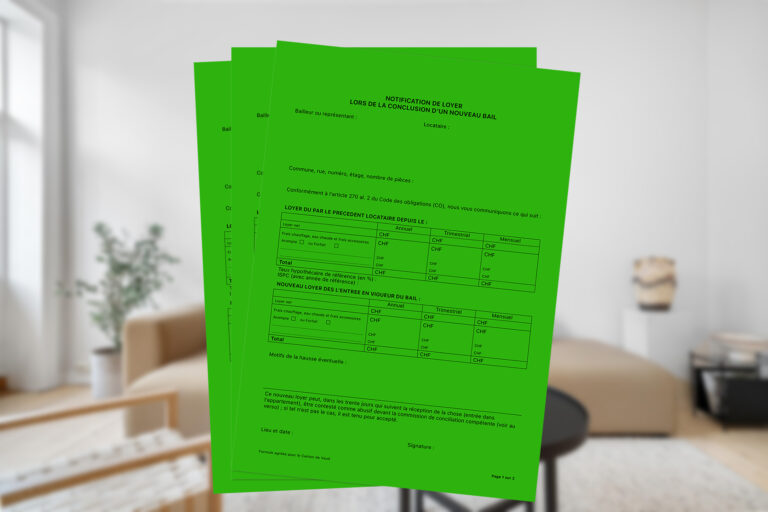🏠 Good to know: 10 tips for renting out your property
You’re moving in with your partner and wondering what to do with your apartment? You’ve inherited a property? Or you’ve had the opportunity to invest in real estate?
Renting your property is a great way to preserve, maintain and increase the value of your real estate assets, while also generating regular income.
But can you really manage everything yourself? What rules must you follow? What are the potential pitfalls?
Here are 10 essential points to know before renting out your property.
1. 📚 Legal foundations
Just because you own the property doesn’t mean you can make up your own rules.
In Switzerland, rental law is governed by:
- Articles 253 to 273 of the Swiss Code of Obligations (CO)
- The Ordinance on the Lease and Farm Lease of Residential and Commercial Premises (OBLF)
- Other federal provisions
- Cantonal rules (e.g., rental practices and usage in the canton of Vaud)
Before offering a property for rent, it’s essential to understand these legal provisions and to know your rights and obligations, including:
- delivering the property in good condition (Art. 256 CO)
- guaranteeing peaceful enjoyment of the property (Art. 256a CO)
- maintaining the property (Art. 256 CO)
- respecting the legal notice periods and termination procedures (Art. 266 CO)
You can also include general terms and conditions or a house rule in your lease agreements.
It’s equally important to be aware of the rights and obligations of your tenants.
⚠️ Not knowing rental law can lead to serious errors — and potentially costly consequences. Start with a solid legal foundation.
2. 📈 Listing your property
Before anything else, assess the local market and determine the appropriate rent, based on:
- the location and condition of the property
- the services and facilities included
- the potential return (rent calculated based on gross yield, net yield or comparable rents)
- the type of rental: furnished or unfurnished, standard or vacation property
💡 Several factors can influence the rent: vacancy rate, proximity to shops, schools, public transport, etc.
⚠️ An abusive rent may be challenged—or even judicially reduced—sometimes significantly below the amount you intended to charge. Caution is essential.
3. 📝 Type of lease
- Open-ended (indefinite) lease: the most common, with termination subject to legal notice periods
- Fixed-term lease: used for temporary rentals or in specific circumstances
You may also choose between different rent structures:
- Fixed rent
- Stepped rent (planned increases at fixed intervals)
- Indexed rent (linked to the consumer price index – ISPC)
4. 👤 Finding the right tenants
An ideal tenant is someone who appreciates the property for what it is, takes care of it, pays rent on time, respects the lease conditions, and promptly notifies you of any problems affecting the property.
Of course, no candidate checks every box—but you can stack the odds in your favour by paying close attention to:
- their financial solvency (debt registry statement, salary certificate)
- their personal and professional situation
- their behaviour during the viewing
- your instinct and general impression
🔍 LPD (Swiss Data Protection Act): This law now strictly limits the information you are allowed to request from applicants.
5. ✍️ Drafting the lease agreement
The lease agreement is the legal bond between you and your tenant throughout the rental period. It must be clear, complete, and fully compliant with Swiss law.
It should contain at least the following key elements:
- the assignment of usage
- the property being rented
- the amount of rent and charges (as a flat rate or as advances)
- the lease duration, termination and renewal terms
- the type of rent structure (stepped, indexed, furnished, vacation rental, etc.)
- the rent deposit (maximum three months’ rent – Art. 257e CO)
⚠️ A poorly drafted or vague lease may lead to disputes—especially if its unclear terms disadvantage the tenant.
6. 📄 Using official forms
In some cantons (like Vaud, Geneva or Neuchâtel), landlords must use a mandatory official form to notify the initial rent when a new lease is signed.
This form must be given to the tenant no later than 30 days after handover of the keys—otherwise, the rent could be considered null and void.
And be careful: errors or omissions in the form can also render it invalid.
7. 🧾 Property inspections (check-in & check-out)
A detailed, dated, and signed inspection report, ideally with photos, is essential to:
- document any existing marks or damages at check-in
- avoid disputes during check-out
- determine what counts as normal wear vs actual damage
⚠️ Without a proper inspection, the cost of repairs may fall to you, the landlord—even if they were caused by the tenant.
8. 🔧 Maintenance and repairs
Both the landlord and tenant must maintain the property—but who pays for what?
Generally speaking:
- the tenant covers minor maintenance (light bulbs, shower hoses, range hood filters…)
- the landlord covers major repairs and structural maintenance
🔍 The landlord must act quickly in case of breakdowns or damage. If you delay, the tenant could claim a “defect of the leased object” and request compensation.
9. 📤 Lease termination
Terminations must be formal and legally compliant, for example:
- minimum 3 months’ notice for residential leases (or more if specified in the lease)
- at the contractual term or, failing that, according to local practice
- sent by registered mail using the official cantonal form
You don’t always need to justify termination—but if the tenant contests, you’ll have to provide a valid reason.
The Swiss Code of Obligations provides an exhaustive list of legal grounds, including:
- genuine personal need for the property
- serious breach of tenant obligations (e.g., unpaid rent, neglect, misconduct)
⚠️ Tenants can contest any termination of an open-ended lease. If they do, you must justify it with one of the legally allowed reasons. “I don’t like the tenant” is not a valid one.
10. 📊 Administrative and accounting follow-up
This is one of the most important and time-consuming aspects of rental management—it continues throughout the life of the lease:
- issuing rent and service charge statements
- handling indexations and regularisations
- sending reminders, formal notices, following up on unpaid rents
- preparing annual service charge breakdowns (if charges are paid as advances)
🧾 Solid accounting is vital to ensure financial control and to facilitate your tax reporting.
⚖️ Managing it yourself? Yes—but not at any cost.
Self-managing can save money—but only if you’re well organised, available, and fully up to date on your legal responsibilities.
A rent dispute, unpaid rent, poorly handled termination or invalid lease clause… All of these can cost far more than a property manager’s fee.
That’s why at MGM Fiduciaire SA, we offer property owners personalised support in every aspect of rental management—administrative, financial and technical.
💬 Questions? Doubts? We’re here to help.
🎓 Why work with a professional?
Given the legal complexity, accounting rigour and administrative burden involved in rental management, many private landlords prefer to work with professionals.
Hiring a fiduciary or property manager means:
- benefiting from legal and technical expertise
- relying on experience with complex cases
- having a single, competent point of contact
- making strategic decisions to enhance the value of your property
At MGM Fiduciaire SA, we’re a local, human-sized agency founded in 1989, led by a federally certified property manager and accountant—both with many years of experience.
💡 We regularly see owners use templates or contracts with major legal flaws that can’t always be corrected after the fact—and that may have significant financial consequences.
Having a neutral, professional intermediary also helps maintain emotional distance from tenant relationships—and make clearer, more objective decisions.
You own one or more rental properties? Let’s talk. We’ll give you a clear, no-obligation quote.
🖇️ Useful links
- Admin.ch – Swiss rental law : https://www.bwo.admin.ch/fr/droit-du-bail
- OBLF – Ordinance on the Lease and Farm Lease of Residential and Commercial Premises (in French)
- RULV – Dispositions paritaires romandes et Règles et usages locatifs du canton de Vaud
- CVI – Chambre vaudoise immobilière
- Nouvelle formule officielle : notification du loyer lors de la conclusion d’un nouveau bail









